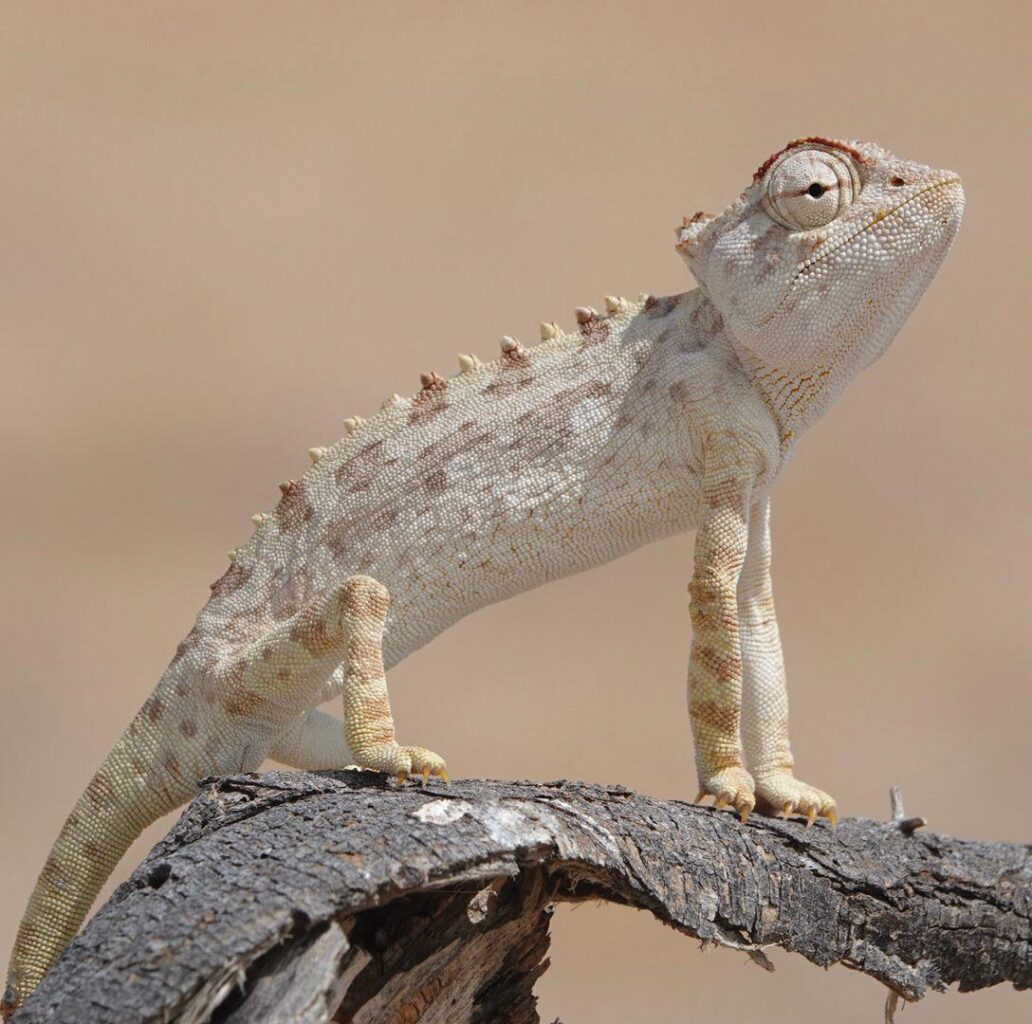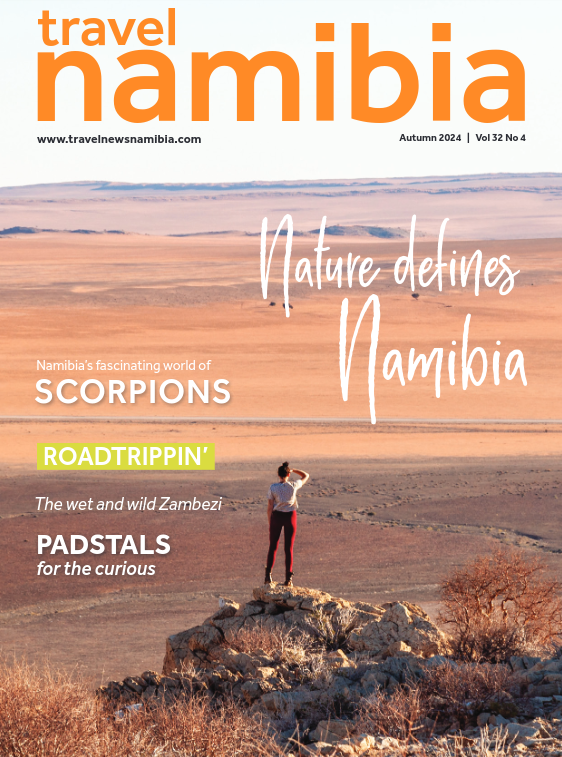

DWARF LIONS
of the desert
The ancient Greeks referred to the chameleon (chamai leon) as dwarf or earth lion because of the fighting spirit the small creature revealed when attacked.
Text Linda de Jager │ Photographs Tertius Jordaan
From the Autumn 2024 issue
Given the fact that the embryo develops underground – the female digs a hole for the eggs and the young have to literally dig their way out – these tiny creatures fight for their survival from the word go.
Namibia’s reptile expert Alfred Schleicher describes the Namaqua chameleon, also known as the desert chameleon, as a small dinosaur. Not only lions inspire awe in Africa.
A conservationist from neighbouring Botswana attests to their defining qualities.“Namaqua chameleons are big and quite bolshy. They patrol the camp at Nossob in Kgalagadi like dragons, hissing at anything they see”, he says.
You will find the Namaqua chameleon in the drier areas of the desert. According to Prof. Krystal Tolle from the South African National Biodiversity Institute it is one of very few specifically desert-living species of chameleon. Other than the Namaqua chameleon, the Arabian species also occur in the desert.
In Namibia’s Erongo Region the D1930 winds its way through dry sand and gravel planes. Eyesee Africa’s Tertius Jordaan, a developer of tailor-made tours in Africa, invited me along to test the quality of the road. The verdict: a good choice for a traveller with a basic 4×4. This area is the habitat of the Namaqua chameleon. We stopped to take photos of such a dwarf lion en route to Uis, just as we were passing the Spitzkoppe. My eye soon caught the trademark swaying movements of a Namaqua chameleon (Chamaeleo namaquensis). Chances are that the goose-stepping chameleon saw me first, given the fact that its eyes can look around in any direction independently, enabling it to accurately estimate distances in the vast Namibian landscape.
Upon closer inspection we discovered a male and female locked in a somewhat macabre dance: the male and female only get together when mating. “Chameleons tend to be loners and do not live in groups nor have social bonds. So individuals will forage alone, sleep alone etc, generally avoiding other chameleons except when mating. If they come in contact and are not mating, they will display to each other until one chameleon retreats to a different branch or bush”, explains Prof. Tolley.
“Chances are that the goose-stepping chameleon saw me first, given the fact that its eyes can look around in any direction independently, enabling it to accurately estimate distances in the vast Namibian landscape”
“Chameleons change colour prior to mating as a means of communicating their receptivity or interest.” We were intrigued to observe that the male, the smaller one of the two, turns brighter in colour and tone, while bobbing its head when approaching the female. Prof. Tolley explained to me later that if the female responds negatively (usually by adopting dark tones or even extremely contrasting dark/ light tones) the male would usually retreat.
I could not help but wonder how many such unique moments had inadvertently been destroyed during the filming of blockbuster movies produced in the Namib Desert. Says conservationist Wendy Wilson, “In 2012, the filming of the Mad Max sequel Fury Road caused significant damage to Namaqua chameleon habitat in Dorob National Park and Namib-Naukluft National Park. They are indeed threatened by all things human, including the introduction of domestic animals, habitat destruction and wildlife trade.” Prof. Tolley confirms that they are sought after in the pet trade. “The species is restricted to South Africa and Namibia and the two countries allow only very few legal exports.”
The Erongo Region is earmarked for ambitious industrial developments, including more mining, as fish resources dwindle. No amount of fierce postering and hissing of such small creatures will protect these two species against the big wheels of the bulldozers of industrial development.
The D1930 takes you to Uis. The Brandberg, Namibia’s highest mountain, dominates the view to the left if you travel further along the C35 on the way to Kamanjab. Here we document yet another chameleon displaying typical behaviour – climbing up on a rock, to cool off. The photo of the little solo dinosaur etched against the relief of a massive mountain, reminded me why I love Namibia: it is in the extremes that you find the delicate nuances. For some perspective, Schleicher writes in his book Reptiles of Namibia that the head-to-body length of a chameleon is 120-150 mm. In stark contrast, the Brandberg towers over the landscape at 2,573 m high. But the desert chameleon and Brandberg do have something in common other than being part of this singular landscape: they both change colour.
The Brandberg is famous for a colour metamorphosis of its own. It starts glowing in the late afternoon sun. And like the word chameleon, the meaning of the word Brandberg captures its essence. It means burning mountain in Afrikaans and German. Says translator and Otjiherero- speaker Richard Tjitua, “The Herero name, Omukuruvaro means Mountain of the Gods. The Damara name for the mountain is Dâures, i.e. Burning Mountain.”
The sun also affects the chameleon: the side turned away from the sun is paler. Writes Schleicher, “This allows better radiation of the heat, thus the body is protected more effectively against the heat.” The ability to change colour is due to special pigment cells. “When they are stressed, they even turn black with anger”, writes Schleicher. The pigments of a chameleon’s skin change and react to nervous stimuli.
Upon revisiting the photographs Jordaan took on this trip (so aptly, in colour) I so wished I could send a skietgebed, a quick prayer, to the divine gods of the Omukuruvaro (Brandberg) asking them to gently hold a protective hand over our very own dwarf lions. TN






